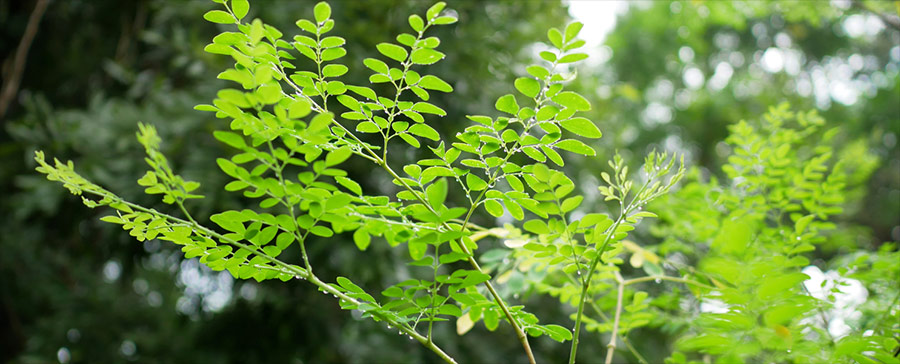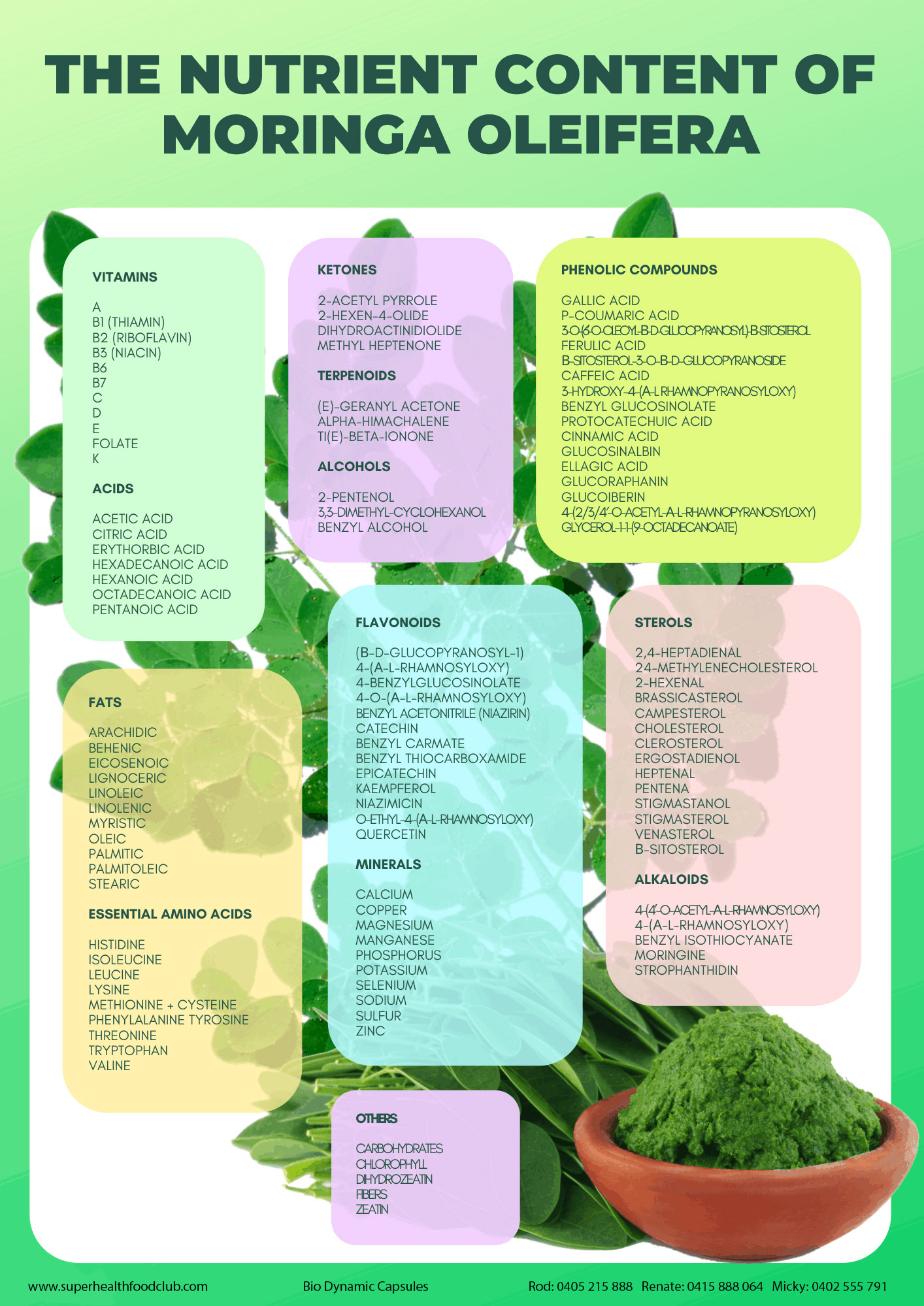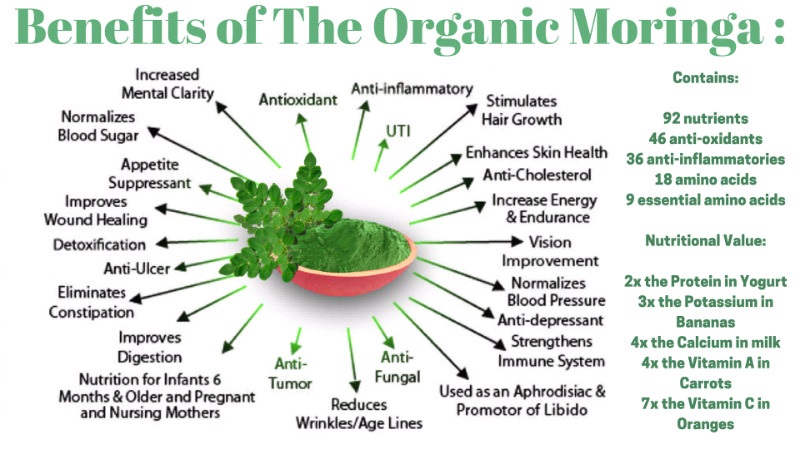Moringa Oleifera called the “TREE OF LIFE”
Has been said to be the “Superfood to beat all Superfoods”.
Moringa Benefits
Moringa Oleifera leaves are rich in Anti-Oxidants, Anti-Inflammatory compounds, Amino Acids and Phyto Nutrients including Vitamins Beta-Carotene, B1, B2, B3, B6, B7, C, Calcium, D, E, Potassium, K, Protein and Iron, to name a few.
- 90+ Nutrients.
- 40+ Anti-Oxidants (ORAC rating 50% higher than Acai Berry).
- 35+ Anti-Inflammatory Agents.
- 20+ types of Amino Acids.
- Omega 3, 6 and 9 oils.
- Full of Phyto-Nutrients.
- 2 times – the protein of Yogurt.
- 7 times – the Vitamin C or Oranges.
- 3 times – the Potassium of Bananas.
- 4 times – the Calcium of Milk.
- 10 times – the Beta-carotene of Carrots.
- 25 times – the Iron than Spinach.
Grown Bio Dynamically on the Island of Fiji by Prem the super turmeric farmer (Who has the family farm for over 146 years and still farmed the traditional way, in volcanic soil and a pristine atmosphere).
- NO Chemical Sprays ( Pesticide – Herbicides or any other cide).
- NO Chemical Fertilisers.
- NO Fillers.
- NO Flow agents.
- Just 100% pure Bio Dynamic Oleifer Leaf encased and pressed into a vegetable capsule.
- (Naturally dried in the shade in moderate temperatures to keep it in its raw state and the most nutritional content).
A list of 92 nutrients:
| 1.iron | 64.Pentena |
| 2.copper | 65.2-Hexenal |
| 3.sodium | 66.Heptenal |
| 4.calcium | 67.2,4-Heptadienal |
| 5.magnesium | Alcohols |
| 6.phosphorus | 68.2-Pentenol |
| 7.potassium | 69.3,3-Dimethyl-Cyclohexanol |
| 8.sulfur | 70.Benzyl alcohol |
| 9.manganese | Ketones |
| 10.zinc | 71.Methyl heptenone |
| 11.selenium | 72. 2-Hexen-4-olide |
| Vitamins | 2-Acetyl pyrrole |
| 12.vitamin B1 (thiamin) | 74.Dihydroactinidolide |
| 13.vitamin E | Terpenoids |
| 14.Vitamin B1 | 75.alpha-Himachalene |
| 15.Vitamin B6 | 76.(E)-Geranyl acetone |
| 16.Vitamin B7 | >77.Ti(E)-beta-Ionone |
| 17.Vitamin D | Acids |
| 18.Vitamin K | 78.Acetic acid |
| 19.vitamin B2 (riboflavin) | 79.Pentanoic acid |
| 20.vitamin B3 (niacin) | 80.Hexanoic acid |
| 21.Vitamin C | 81.Octadecanoic acid |
| Amino acids | 82.Hexadecanoic acid |
| 22.aspartic acid | 83. erythrobic acid |
| 23.glutamic acid | 84.citric acid |
| 24.serine | Others |
| 25.glycine | 85.meChlorophyll |
| 26.threonine | 86.meDihydrozeatin |
| 27.alanine | 87.Zeatin |
| 28.valine | 88.Carbohydrates |
| 29.leucine | 89.fibers |
| 30.isoleucine | Alkaloids |
| 31.histidine | 90.Moringine |
| 32.lysine | 91.Strophantidin |
| 33.arginine | 92.4-(α-l-rhamnosyloxy) |
| 34.phenylalanine | 93.benzyl isothiocyanate |
| 35.tryptophan | 94.4-(4’-O-acetyl-α-l-rhamnosyloxy) |
| 36.cystine | 95.benzyl isothioyanate |
| 37.proline | Flavonoids |
| 38.tyrosine | 96.Catechin |
| 39.methionine | 97 (β-d-glucopyranosyl-1) |
| 40.cysteine | 98.benzyl thiocarboxamide |
| 41.phenylalanine | 99.Epicatechin |
| 42.choline | 100.4-O-(α-l-rhamnosyloxy) |
| Fats | 101.benzyl glucosinolate |
| 43.Myristic | 102.Quercetin |
| 44.Palmitic | 103.4-benzylglucosinolate |
| 45.Palmitoleic | 104.Kaempferol |
| 46.Stearic | 105.Niazimicin |
| 47.Oleic | 106.4-(α-l-rhamnosyloxy) |
| 48.Linoleic | 107.benzyl acetonitrile (niazirin) |
| 49.Linolenic | 108.O-ethyl-4-(α-l-rhamnosyloxy) |
| 50.Arachidic | 109.benzyl carmate |
| 51.Eicosenoic | Phenolic |
| 52.Behenic | 110.Gallic acid |
| 53.Lignoceric | 111.Glycerol-1-1-(9-octadecanoate) |
| Sterols | 112.p-Coumaric acid |
| 54.Cholesterol | 113.3-O-(6’-O-oleoyl-β-d-glucopyranosyl)-β-sitosterol |
| 55.Brassicasterol | 114.Ferulic acid |
| 56.24-methylenecholesterol | 115.β-sitosterol-3-O-β-d-glucopyranoside |
| 57.Campesterol | 116.Caffeic acid |
| 58.Stigmasterol | 117.3-Hydroxy-4-(α-l-rhamnopyranosyloxy) |
| 59.Ergostadienol | 118.benzyl glucosinolate |
| 60.Clerosterol | 119.Protocatechuic acid |
| 61.Stigmastanol | 120.4-(2/3/4′-O-acetyl-α-l-rhamnopyranosyloxy) |
| 62.β-sitosterol | 121.benzyl glucosinolate |
| 63.venasterol | 122.Cinnamic acid |
| 123.Glucosinalbin | |
| 124.Ellagic acid | |
| 125.Glucoraphanin | |
| 126.Glucoiberin |
A list of the 46 natural antioxidants (and more):
Antioxidants (9, 11, 12, 13, 14, 15)
- β-carotene
- calcium
- potassium
- quercetin
- chlorogenic acid
- hydroxyanisole (BHA)
- butylated hydroxytoluene (BHT)
- tertiary-butylhydroquinones
- propyl gallate
- vitamin E (tocopherols)
- vitamin C
- glucose oxidase
- reduced glutathione
- citric acid
- polyphospages
- aminopolycarboxylic acids
- vanillin
- moringine
- strophantidin
- 4-(α-l-rhamnosyloxy)
- benzyl isothiocyanate
- 4-(4’-O-acetyl-α-l-rhamnosyloxy)
- benzyl isothioyanate
- catechin
- 4-(β-d-glucopyranosyl-1→4-α-l-rhamnopyranosyloxy)
- benzyl thiocarboxamide
- epicatechin
- 4-O-(α-l-rhamnosyloxy)
- benzyl glucosinolate
- 4-(α-l-rhamnopyranosyloxy)-benzylglucosinolate
- Kaempferol
- Niazimicin
- 4-(α-l-rhamnosyloxy)
- benzyl acetonitrile (niazirin)
- O-ethyl-4-(α-l-rhamnosyloxy)
- benzyl carmate
- Gallic acid
- Glycerol-1-1-(9-octadecanoate)
- p-Coumaric acid
- 3-O-(6’-O-oleoyl-β-d-glucopyranosyl)-β-sitosterol
- Ferulic acid
- β-sitosterol-3-O-β-d-glucopyranoside
- Caffeic acid
- 3-Hydroxy-4-(α-l-rhamnopyranosyloxy)
- benzyl glucosinolate
- Protocatechuic acid
- 4-(2/3/4′-O-acetyl-α-l-rhamnopyranosyloxy)
- benzyl glucosinolate
- cinnamic acid
- glucosinalbin
- ellagic acid
- glucoraphanin
- glucoiber
71 Antimicrobial/biocidal benefits
- Aspergillus flavin
- Trichoderma sp
- Staphylococcus aureus
- Shigella dysenteriae
- Shigella boydii
- Bacillus megaterium
- Escherichia coli
- Enterobacter aerogenes
- Providencia stuartii
- Klebsiella pneumoniae
- Pseudomonas aeruginosa
- Bacillus subtilis
- Mycobacterium phlei
- Bacillus cereus
- Sarcina lutea
- Basidiobolus ranarum
- Basidiobolus haptosporus
- Propionibacterium acnes
- Staph epidermis
- Strep pyogenes
- Trichophyton mentagrophytes
- Microsporum canis
- Trichophyton rubrum
- Epidermophyton floccosum
- Pseudomonas fluorescens
- Citrobacter freundii
- Serratia marcescens
- Enterobacter sp.
- Salmonella sp.
- Proteus vulgaris
- Streptococcus mutans
- Vibrio parahaemolyticus
- Enterococcus faecalis
- Aeromonas cavieae
- Streptococcus aureus
- Streptococcus mutans
- Penicillium expansum
- Penicillium digitatum
- Penicillium aurantiogriseum
- Penicillium citrinum
- Aspergillus niger spp.
- Microcytis aeruginosa
- Salmonella typhi
- Vibrio cholera
- Candida albicans
- Syphilis
- Typhoid
- Urinary Tract Infection
- Thrush
- Viral Common cold
- Epstein-Barr Virus
- Herpes Simplex Virus (HSV-1)
- HIV-AIDS
- HBV
- Mouth disease virus
- Foot disease virus
- Warts
- Dranunculiasis (guinea-worm)
- Schistosomes
- Trypanosomes
- Bronchitis
- Earache
- External Sores/Ulcers
- Fever
- Hepatic infections
- Skin (Dermal) infections
- Throat Infection
- Water treatment (general)
- Asthma
- Malaria
- Trypanosoma
Cancer therapy/protection
- Cancer therapy
- Anti-tumour
- Prostate cancer
- Colon cancer
- Lung cancer
- Oesophageal cancer
- Neuroblastoma
- Astrocytoma
- Liver cancer
- Breast cancer
- Ovarian cancer
- Radioprotective
Circulatory/endocrine disorders
- Anti-anaemic
- Anti-hypertensive
- Cardiotonic
- Diabetes
- Hypoglycaemia
- Diuretic
- Hypocholestemia
- Hypolipidemic
- Thyroid
- Goitre
- Tonic
- Hepatorenal
- Cardioprotective
- Cardiac arrhythmia
- Coronary artery disease
- Cardiac hypertrophy
- Myocardial infarction
- Heart failure
Detoxification
- Antipyretic
- Purgative
- Snakebite
- Scorpion-bite
- Insect bites
- Oxidative DNA damage protective
- Antiperoxidative
- Tsetse fly bites
Digestive disorders
- Colitis
- Diarrhoea
- Digestive
- Dysentery
- Flatulence
- Stomach ulcers
- Intestinal ulcers
- Gastritis
- Intestinal spasms
- Swelling
- Liver fibrosis
- Fatty liver
- Aiding digestion
Inflammation
- Rheumatism
- Joint pain
- Oedema
- Arthritis
- Abscesses
Immunity
- Immune stimulant
- Weak immunity
- Lupus
Nervous disorders
- Anti-spasmodic
- Epilepsy
- Hysteria
- Headache
- Paralysis
- Convulsions
- Reduce pain
Moringa oleifera & nutrition
- Anti-nutritional factors
- Antioxidant
- Carotenoids
- Energy
- Goitrogen
- Iron deficiency
- Oil quality
- Protein
- Vitamin/mineral deficiency
- Malnutrition
Reproductive health & Moringa oleifera
- Abortifacient
- Aphrodisiac
- Birth Control
- Lactation enhancer
- Prostate function
- Increase sex drive
- Improves the quality and flow of mothers’ milk
- Sexually transmitted diseases
- Help during labour
Skin disorders & Moringa oleifera
- Antiseptic
- Astringent
- Pyodermia
- Rubefacient
- Vesicant
- Boils
- Fire burn wounds
- Skin rashes
Others
- Bladder
- Urination problems
- Catarrh
- Gout
- Hepatamegaly
- Lactation
- Low back pain
- Kidney pain
- Kidney stones
- Scurvy
- Splenomegaly
- Athlete’s foot
- Dandruff
- Warts
- Weakness of thigh
- Weakness of calf muscles
- Wounds
- Obesity
- Muscle diseases
- Hysteria
- Colds
- Coughs
- Eye infections
- Throat infections
- Dental decay
- Aphrodisiac
- Dental caries/toothache



